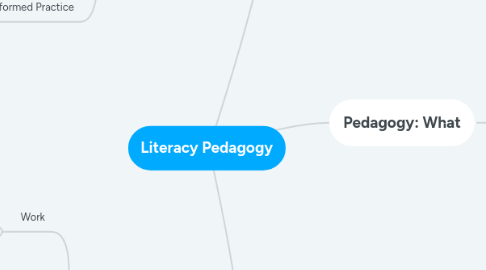
1. Social Changes
1.1. Work
1.1.1. New management theory utilized a great deal of educational terminology.
1.1.2. New language
1.1.3. New technology
1.1.4. Traditional work structures are being replaced by relationship pedagogy.
1.2. Public
1.2.1. Importance of public areas is declining
1.2.2. Roles have shifted for schools
1.2.3. Cultural diversity is extremely important in education due to changes
1.3. Private
1.3.1. Cultural differences are more significant
1.3.2. Private lives are made more public
1.3.3. There is not much support for for childhood diversity among children and adolescents in regards to media.
2. Pedagogy: How
2.1. Situated Practice
2.1.1. An individual achieves mastery in practice then they are placed into a community where they utilize their skills.
2.1.2. Learners must be in an environment that promotes taking and supports the individuals while risks are being taken.
2.2. Overt Instruction
2.2.1. Utilizes active interventions and promotes scaffolding from teachers.
2.3. Critical Framing
2.3.1. Uses metalanguages
2.3.2. Students have growth in mastery through practice.
2.3.3. Through critical framing, students are setting them up for transformed practice.
2.4. Transformed Practice
2.4.1. Allows for students to demonstrate skills in a reflective manner
2.4.2. Encourages students to develop new practices based on their personal values.
3. Pedagogy: What
3.1. Designs of Meaning
3.1.1. Provides more opportunity that traditional approaches
3.1.2. Teachers and managers are viewed as designers in the educational process.
3.2. Dimensions of Meaning
3.2.1. Metalanguage - languages for discussion on language
3.2.2. Metalanguage used within schools should be flexible, open ended, and should be aligned to needs so that it encourages teachers to utilize it.
3.2.3. Primary purpose - to identify and explain differences in text, relate the texts to culture and situation they are within.
3.3. Design Elements
3.3.1. Linguistic Design - nominalization (using a phrase to relay a large amount of information) and transitivity (agency and effort in a sentence)
3.3.2. Visual Design - images, page layouts, screen formats
3.3.3. Audio Design - sounds effects, music
3.3.4. Gestural Design - Body gestures/language
3.3.5. Spatial Design - architectural/environmental spaces
3.3.6. Multimodal Design - patterns of correlation among the other modes. Relates to all the types of design elements.
